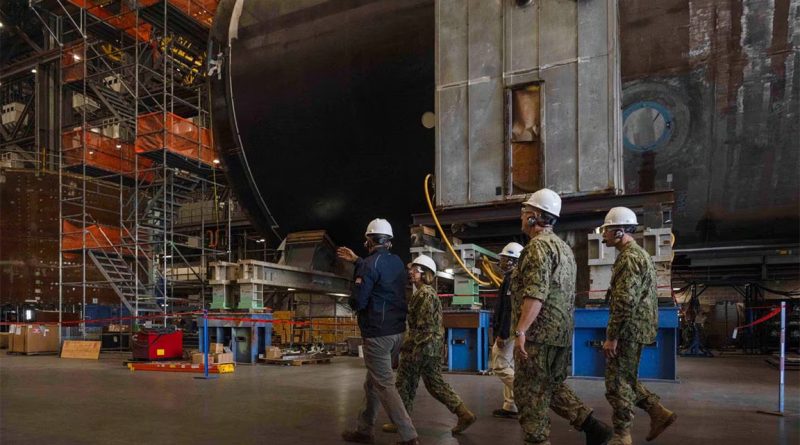Can 3D printing save submarine manufacturing?
In the complex world of naval defense, the United States Navy faces a formidable challenge: maintaining and expanding its critical submarine fleet amidst shrinking manufacturing resources and escalating demands. The fleet’s resilience hinges on innovative solutions, and one such potential game-changer is 3D printing or additive manufacturing (AM). This technology, initially used for basic prototyping, has evolved into a sophisticated tool, capable of creating complex, end-use parts in both plastic and metal, meeting or exceeding the needs of most applications.
This introduction sets the stage for exploring how the Navy is turning to 3D printing to address its submarine fleet challenges, signaling a pivotal shift in manufacturing technologies.
The Naval Shift to 3D Printing
The U.S. Navy’s proactive adoption of 3D printing in submarine construction is not just a technological upgrade but a strategic necessity. At the Additive Manufacturing Center of Excellence in Danville, Virginia, a new era in submarine manufacturing is unfolding. Here, the focus is not on traditional methods with their associated heat and noise but on precise, clean, and efficient 3D printing processes. This shift comes in the wake of a stark reality: the Navy’s submarine industrial base has seen a more than 70% reduction in suppliers since the 1980s, exacerbating the challenge of meeting the growing demands for ballistic missile and attack submarines.
Practical Applications and Success Stories
In this era of manufacturing innovation, the Navy has already started reaping the benefits of 3D printing. Notable successes include the installation of a 3D-printed ventilation diffuser on an Ohio-class ballistic missile submarine and a critical valve for another submarine. These parts, which might have taken years to procure through conventional means, were rapidly produced and installed, showcasing 3D printing’s potential to revolutionize maintenance and construction timelines. Moreover, the Navy’s collaboration with the state of Virginia and industry partners at the Additive Manufacturing Center of Excellence is establishing a robust network for managing the increased workload, further cementing 3D printing’s role in submarine manufacturing.
Future Prospects and Industry Collaboration
The Navy’s race against time to integrate 3D printing in submarine manufacturing is driven by a looming deadline: the need to produce one Columbia and two Virginia-class submarines annually. This ambitious goal necessitates bold moves and a degree of shared risk, highlighting the critical role of industry collaboration in this endeavor. The involvement of industry partners is essential, as evidenced by the 50,000-person shortage in the additive manufacturing workforce and the increasing demand for these specialized skills.
Advantages of 3D Printing in Submarine Manufacturing
The adoption of 3D printing in submarine manufacturing offers a plethora of advantages, ranging from timely construction and customization to cost-efficiency and sustainability. This technology allows for the rapid production of tailored parts, essential for the diverse requirements of each submarine. Furthermore, the reduction in waste and the potential for continuous design and performance improvement position 3D printing as a cornerstone of innovative manufacturing. Additionally, Thyssenkrupp Marine Systems’ approach to using 3D printing for manufacturing submarine parts further underscores the significant weight reductions and efficiency gains achievable through this technology.
Global 3D Printing Trends and Innovations
The global 3D printing landscape is marked by continuous growth and innovation. Fused deposition modeling (FDM) remains a popular additive technology, and the sector is witnessing a significant increase in market growth and order sizes. Innovations in large-format metal additive manufacturing and the development of new materials are driving this growth forward. Software advancements, particularly in automation, are enhancing the efficiency and quality of 3D printing processes. The integration of AI in 3D printing is set to revolutionize manufacturing, offering new possibilities in quality control, generative design, and print optimization.
Challenges and Solutions in 3D Printing
Despite its potential, 3D printing faces several challenges. Speed limitations and size constraints are significant technical hurdles, especially when scaling up production volumes. However, advancements in large-format printing and automation are addressing these challenges. Environmental concerns, particularly regarding the use of plastics and waste management, are also being tackled through the development of renewable materials and robust recycling processes. Additionally, bridging the knowledge and skills gap in additive manufacturing remains a priority to fully harness the technology’s capabilities.
The U.S. Navy’s embrace of 3D printing in submarine manufacturing is a testament to its commitment to technological advancement and operational efficiency. As the Navy navigates the complexities of modern warfare and fleet maintenance, additive manufacturing stands as a beacon of innovation, offering a blend of agility, precision, and sustainability. The lessons learned and successes achieved in this endeavor will not only shape the future of naval warfare but also influence the broader landscape of manufacturing technologies.
